Cataclastic Characteristics and Formation Mechanism of Dolomite Rock Mass in Yunnan, China
Abstract
:1. Introduction
2. Methods
2.1. In-Hole Television
2.2. Wave Velocity Test
2.3. 3D Laser Scanning Technology
- (1)
- S/V, where S and V are the block’s surface area and volume, respectively. S/V is used to evaluate the complexity of the surface morphology of the blocks; the larger the S/V, the more complex the surface morphology.
- (2)
- SD is used to evaluate the overall shape characteristics of the blocks, and it is given by:where S is the surface area of the block and S1 is the surface area of the same volume of the sphere of the blocks ().
- (3)
- SF is used to evaluate the pin-like properties of the blocks, reflecting the near pin-like, lamellar, or sub-rectangular shape of the blocks, and it is given by:where la, lb, and lc are the lengths of the long axis, middle axis, and short axis, respectively.
- (4)
- V/V2, where V is the block volume, and V2 is the simulated volume of the best externally cut sphere of the blocks. V/V2 is used to evaluate the overall angular characteristics of the blocks; the smaller the V/V2, the more significant the block’s angularity.
- (5)
2.4. Photogrammetry
2.5. Image Processing Technology
2.6. SEM
3. Results and Discussion
3.1. Macroscopic Fracture Characteristics of Rock Mass
3.1.1. In-Hole Television Image Analysis
3.1.2. Analysis of Borehole Shear Wave Velocity
3.1.3. Analysis of Typical Excavation Profile
3.1.4. Block Geometry Analysis
3.2. Microfracture Characteristics of Rock Masses
3.3. Analysis of Rock Fracture Formation Mechanisms
4. Conclusions
- (1)
- Within the depth range of the borehole exposures, the degree of fragmentation of the rock mass generally decreases with increasing depth, the decrease is not significant, and differential fragmentation occurs locally, but the rock mass is generally fragmented. Most borehole cores are fragmented and fractured, with a basic RQD value of 0 and a basic rock quality grade of V. Part of the borehole cores are block fractured, with an RQD value of less than 10% and a basic rock quality grade of IV. These can provide a basis for rock mass classification. According to the Geological Engineering Handbook [1], the rock quality designation is very poor.
- (2)
- The shear wave velocity can be used to estimate the integrity of the rock mass and determine the site classifications. The shear wave velocity of the dolomite on the high slope generally increases with the depth of the borehole, but the increase is very small. Part of the shear wave velocity has a tendency to decrease, and the integrity of the rock mass should be broken or very broken. According to GB 50011 (2010) [25], the site classification of YPP is Level I1.
- (3)
- The rock structure revealed by the excavation section is fragmented, the degree of rock mass integrity is fragmented, and the rock structural type is mainly fractured. The degree of fragmentation varies from one rock layer to another. The thinner the rock layer is, the smaller the spacing of the muddied interlayer is; that is, the closer it is to the muddied interlayer, the more fragmented the rock mass is. The discontinuities are mainly facies, muddied inclusions, bedding joints, and shear joints, some of which are slightly staggered along the bedding joints. The joints are straight, smooth, interconnected, and largely unfilled, with each set of joints parallel to each other. The discontinuities are extremely well developed, with fracture spacing at the centimeter level, some even less than 1 cm. The discontinuities can be divided into six sets, the first set being muddied interlayer, the second set being bedding joints, and the remaining four sets being shear joints. The unloading effect generated by excavation causes the slope to slide along the bedding joints and muddied interlayer, leading to the failure of the support systems.
- (4)
- The angles of the blocks of different grain sizes are sharp, and the overall angularity of the blocks is more evident than that of the cubes, with roundness being angular and sharp-angled. The discontinuities are flat and smooth; each block has multiple sets of mutually parallel discontinuities. The smaller the blocks, the more complex the surface morphology. The angular and sharp-angled blocks indicate that tectonics mainly control dolomite fracturing.
- (5)
- Scanning electron microscope observations show that the ultra-micro fractures are not flat and smooth, the fractures are folded, and the fracture opening is mainly on the micron scale. The fractures do not cut through the crystals but mainly split along the intercrystalline and crystal interfaces, and the crystal structure on both sides of the fracture is intact. These ultra-micro fracture features also indicate that the fracturing of dolomite is mainly controlled by tectonics and almost unaffected by surface weathering.
- (6)
- Chemical weathering is not the main mechanism of dolomite fragmentation. The fracturing of dolomite is mainly related to the original sedimentary construction and tectonics.
Author Contributions
Funding
Institutional Review Board Statement
Informed Consent Statement
Data Availability Statement
Acknowledgments
Conflicts of Interest
References
- Editorial Board of Geological Engineering Handbook. Geological Engineering Handbook, 5th ed.; China Construction Industry Press: Beijing, China, 2018; pp. 15–16. (In Chinese) [Google Scholar]
- Costamagna, E.; Oggeri, C.; Vinai, R. Damage and contour quality in rock excavations for quarrying and tunnelling: Assessment for properties and solutions for stability. IOP Conf. Ser. Earth Environ. Sci. 2021, 883, 012137. [Google Scholar] [CrossRef]
- Ruiz-Carulla, R.; Corominas, J.; Mavrouli, O. A fractal fragmentation model for rockfalls. Landslides 2017, 14, 875–889. [Google Scholar] [CrossRef]
- Ferrero, A.M.; Forlani, G.; Roncella, R.; Voyat, H.I. Advanced geostructural survey methods applied to rock mass characterization. Rock Mech. Rock Eng. 2009, 42, 631–665. [Google Scholar] [CrossRef]
- Han, Z.; Wang, C.; Hu, S.; Wang, Y. Application of borehole camera technology in fractured rock mass investigation of a submarine tunnel. J. Coast. Res. 2019, 83, 609–614. [Google Scholar] [CrossRef]
- Hong, E.S.; Lee, I.M.; Lee, J.S. Measurement of rock joint roughness by 3D scanner. Geotech. Test. J. 2006, 29, 482–489. [Google Scholar] [CrossRef]
- Feng, Q.H.; Röshoff, K. In-situ mapping and documentation of rock faces using a full-coverage 3d laser scanning technique. Int. J. Rock Mech. Min. Sci. 2004, 41, 139–144. [Google Scholar] [CrossRef]
- Ismail, A.; Safuan, A.R.A.; Sa’ari, R.; Rasib, A.W.; Mustaffar, M.; Abdullah, R.A.; Kassim, A.; Yusof, N.M.; Rahaman, N.A.; Kalatehjari, R.; et al. Application of combined terrestrial laser scanning and unmanned aerial vehicle digital photogrammetry method in high rock slope stability analysis: A case study. Measurement 2022, 195, 111161. [Google Scholar] [CrossRef]
- Chen, S.; Walske, M.L.; Davies, I.J. Rapid mapping and analysing rock mass discontinuities with 3D terrestrial laser scanning in the underground excavation. Int. J. Rock Mech. Min. Sci. 2018, 110, 28–35. [Google Scholar] [CrossRef]
- Hudson, R.; Faraj, F.; Fotopoulos, G. Review of close-range three-dimensional laser scanning of geological hand samples. Earth-Sci. Rev. 2020, 210, 103321. [Google Scholar] [CrossRef]
- Riquelme, A.; Cano, M.; Tomás, R.; Abellán, A. Identification of rock slope discontinuity sets from laser scanner and photogrammetric point clouds: A comparative analysis. Procedia Eng. 2017, 191, 838–845. [Google Scholar] [CrossRef]
- Liu, H.Y.; Kou, S.Q.; Lindqvist, P.A.; Tang, C. Numerical simulation of the rock fragmentation process induced by indenters. Int. J. Rock Mech. Min. Sci. 2002, 39, 491–505. [Google Scholar] [CrossRef]
- Hatzor, Y.H.; Arzi, A.A.; Zaslavsky, Y.; Shapira, A. Dynamic stability analysis of jointed rock slopes using the DDA method: King Herod’s Palace, Masada, Israel. Int. J. Rock Mech. Min. Sci. 2004, 41, 813–832. [Google Scholar] [CrossRef]
- Ortlepp, W.D. Observation of mining-induced faults in an intact rock mass at depth. Int. J. Rock Mech. Min. Sci. 2000, 37, 423–436. [Google Scholar] [CrossRef]
- Zhuang, Y.; Xing, A.; Leng, Y.; Bilal, M.; Zhang, Y.; Jin, K.; He, J. Investigation of characteristics of long runout landslides based on the multi-source data collaboration: A case study of the Shuicheng Basalt landslide in Guizhou, China. Rock Mech. Rock Eng. 2021, 54, 3783–3798. [Google Scholar] [CrossRef]
- Chen, Z.; Zhang, Z.L.; Wu, K. Application of single-hole and inter-hole velocity test in engineering construction. J. Geol. 2010, 34, 192–195, (In Chinese with English Abstract). [Google Scholar] [CrossRef]
- Warburton, P.M. Vector stability analysis of an arbitrary polyhedral rock block with any number of free faces. Int. J. Rock Mech. Min. Sci. Geomech. Abstr. 1981, 18, 415–427. [Google Scholar] [CrossRef]
- Yarahmadi, R.; Bagherpour, R.; Sousa, L.M.O.; Taherian, S.-G. How to determine the appropriate methods to identify the geometry of in situ rock blocks in dimension stones. Environ. Earth Sci. 2015, 74, 6779–6790. [Google Scholar] [CrossRef]
- Segall, P.; Pollard, D.D. Joint formation in granitic rock of the Sierra Nevada. GSA Bull. 1983, 94, 563–575. [Google Scholar] [CrossRef]
- Bazarnil, M. Slope stability monitoring in open pit mines using 3D terrestrial laser scanning. E3S Web Conf. 2018, 66, 01020. [Google Scholar] [CrossRef]
- Zingg, T. Beitrag zur Schotteranalyse. Ph.D. Thesis, ETH Zürich, Zurich, Switzerland, 1935. (In Schweizer Deutsch). [Google Scholar] [CrossRef]
- Masad, E.; Button, J.W. Unified imaging approach for measuring aggregate angularity and texture. Comput.-Aided Civ. Infrastruct. Eng. 2000, 15, 273–280. [Google Scholar] [CrossRef]
- Anochie-Boateng, J.K.; Komba, J.J.; Mvelase, G.M. Three-dimensional laser scanning technique to quantify aggregate and ballast shape properties. Constr. Build. Mater. 2013, 43, 389–398. [Google Scholar] [CrossRef]
- GB 50287; Code for Hydropower Engineering Geological Investigation. Ministry of Housing and Urban-Rural Construction of the People’s Republic of China: Beijing, China, 2016. (In Chinese)
- GB 50011; Code for Seismic Design of Buildings. Ministry of Housing and Urban-Rural Construction of the People’s Republic of China: Beijing, China, 2010. (In Chinese)
- Zhao, C.L.; Zhu, X.M. Sedimentary Petrology, 3rd ed.; Petroleum Industry Press: Beijing, China, 2001; pp. 50–53. (In Chinese) [Google Scholar]
- Xu, Z.M.; Huang, R.Q. The assessment of the weathering intensity of Emeishan basalt based on rock blocks (III): Assessment of existing chemical weathering indices. Geol. China 2013, 40, 1655–1665, (In Chinese with English Abstract). [Google Scholar] [CrossRef]
- Xu, Z.M.; Huang, R.Q. The assessment of the weathering intensity of Emeishan basalt based on rock blocks (IV): A proposed weathering index (FF). Geol. China 2013, 40, 1942–1948, (In Chinese with English Abstract). [Google Scholar] [CrossRef]
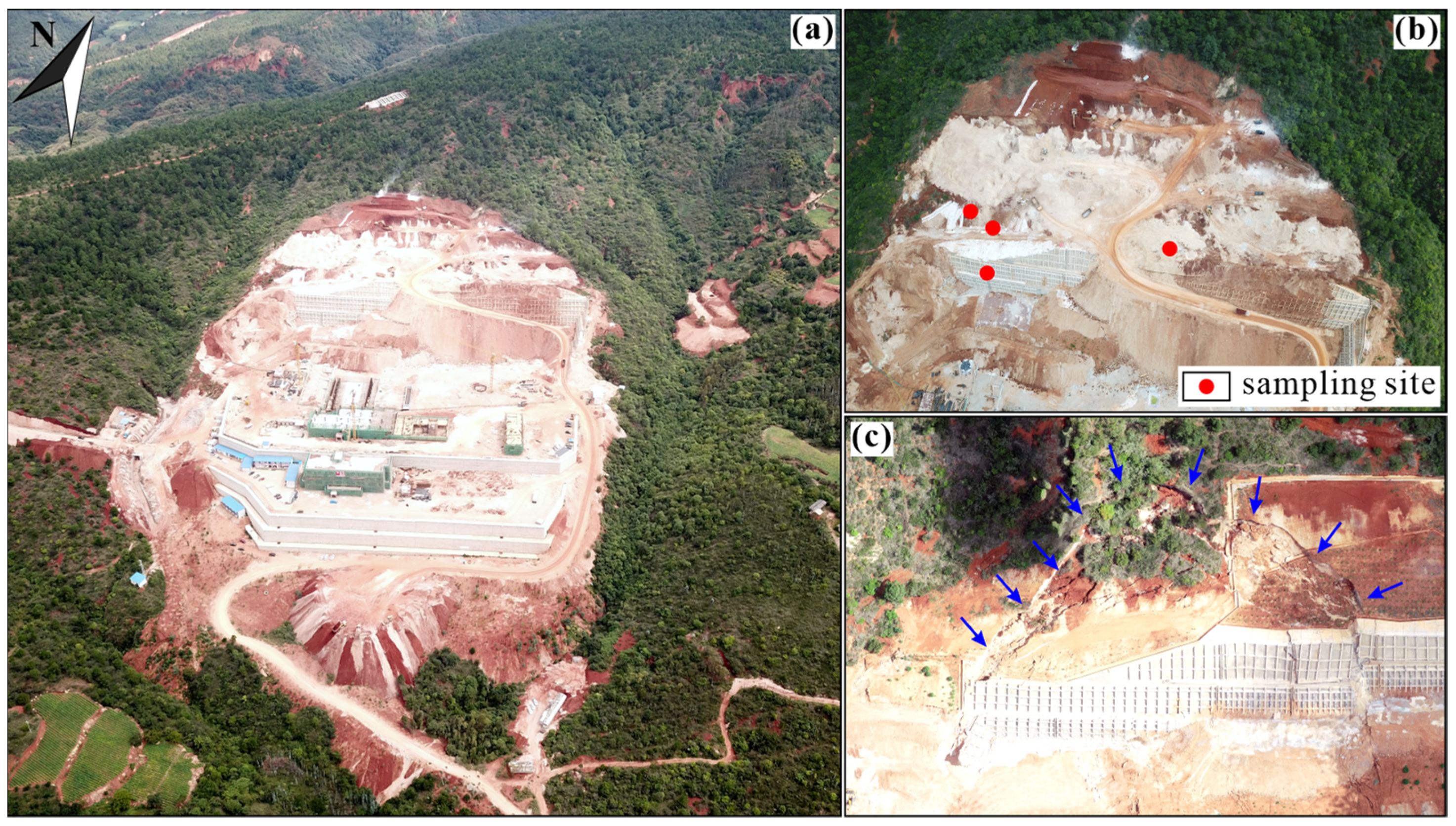

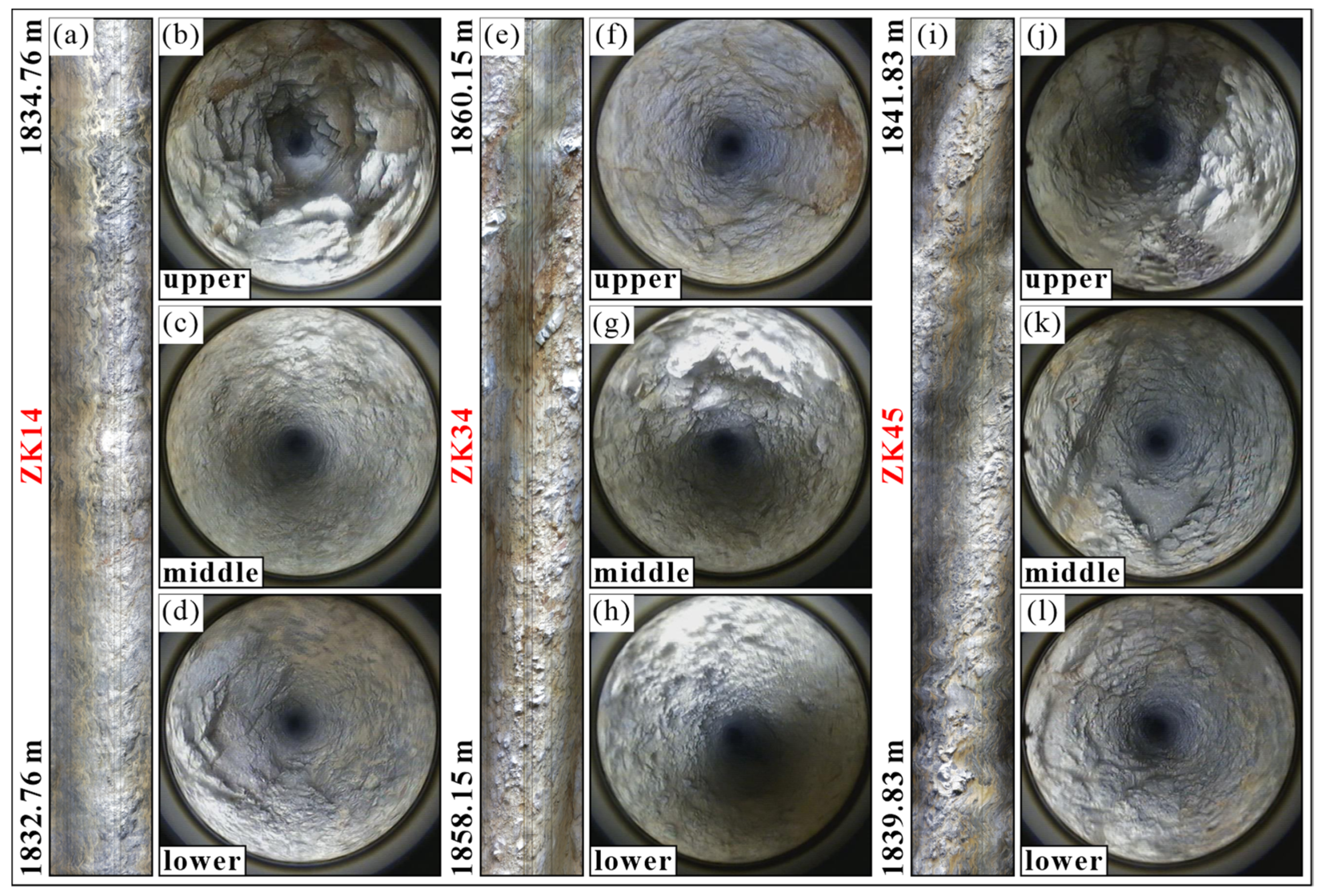


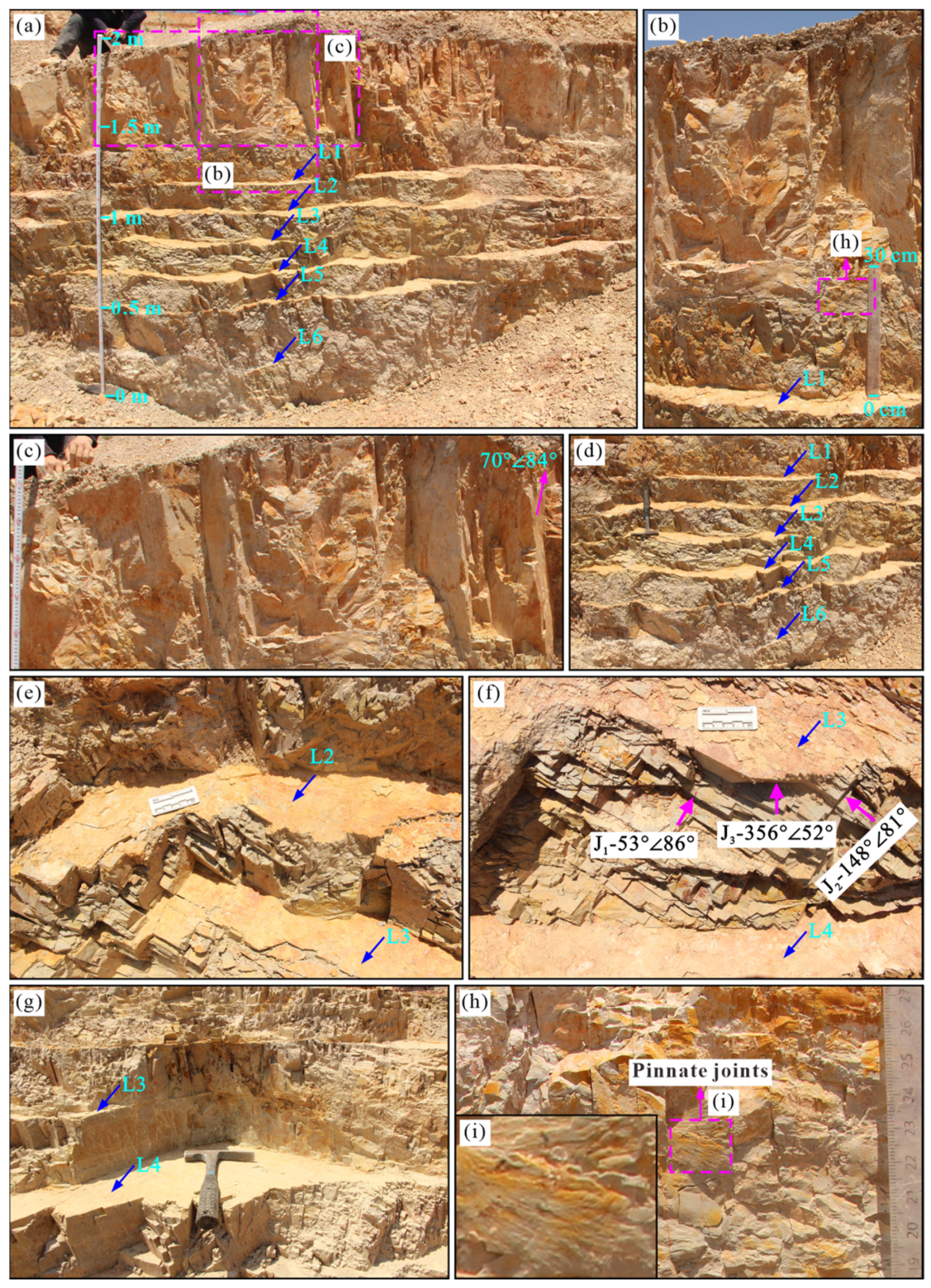
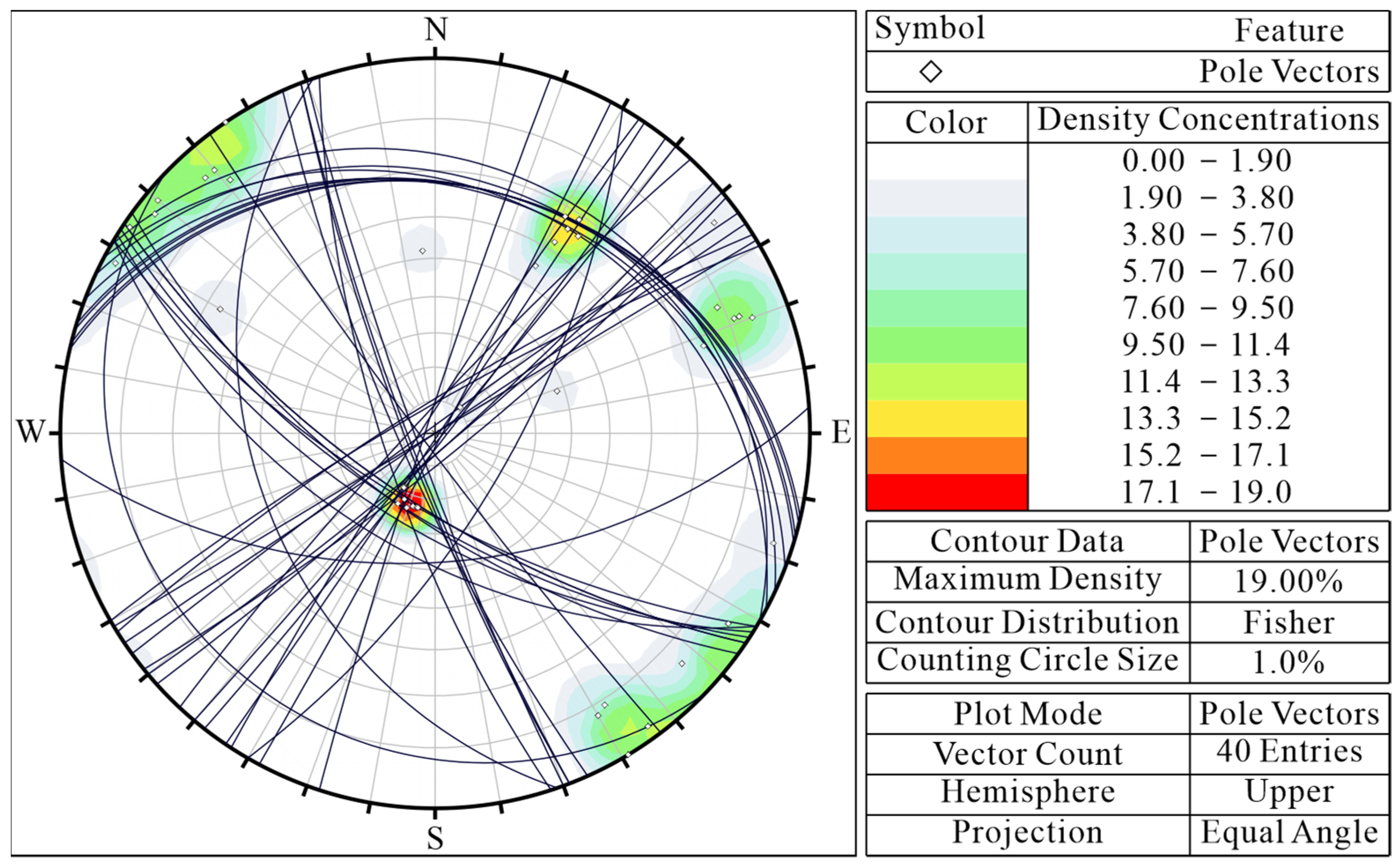
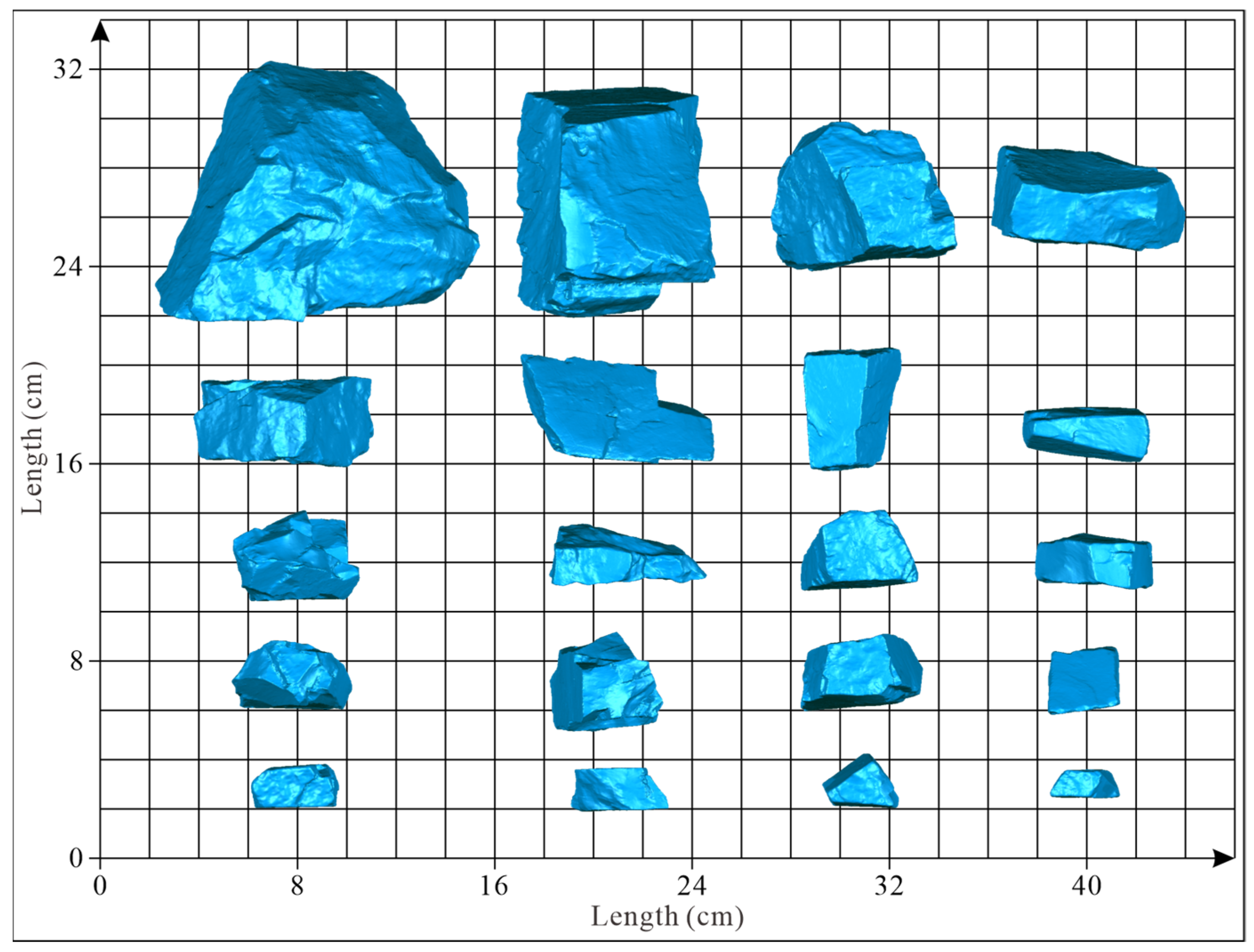
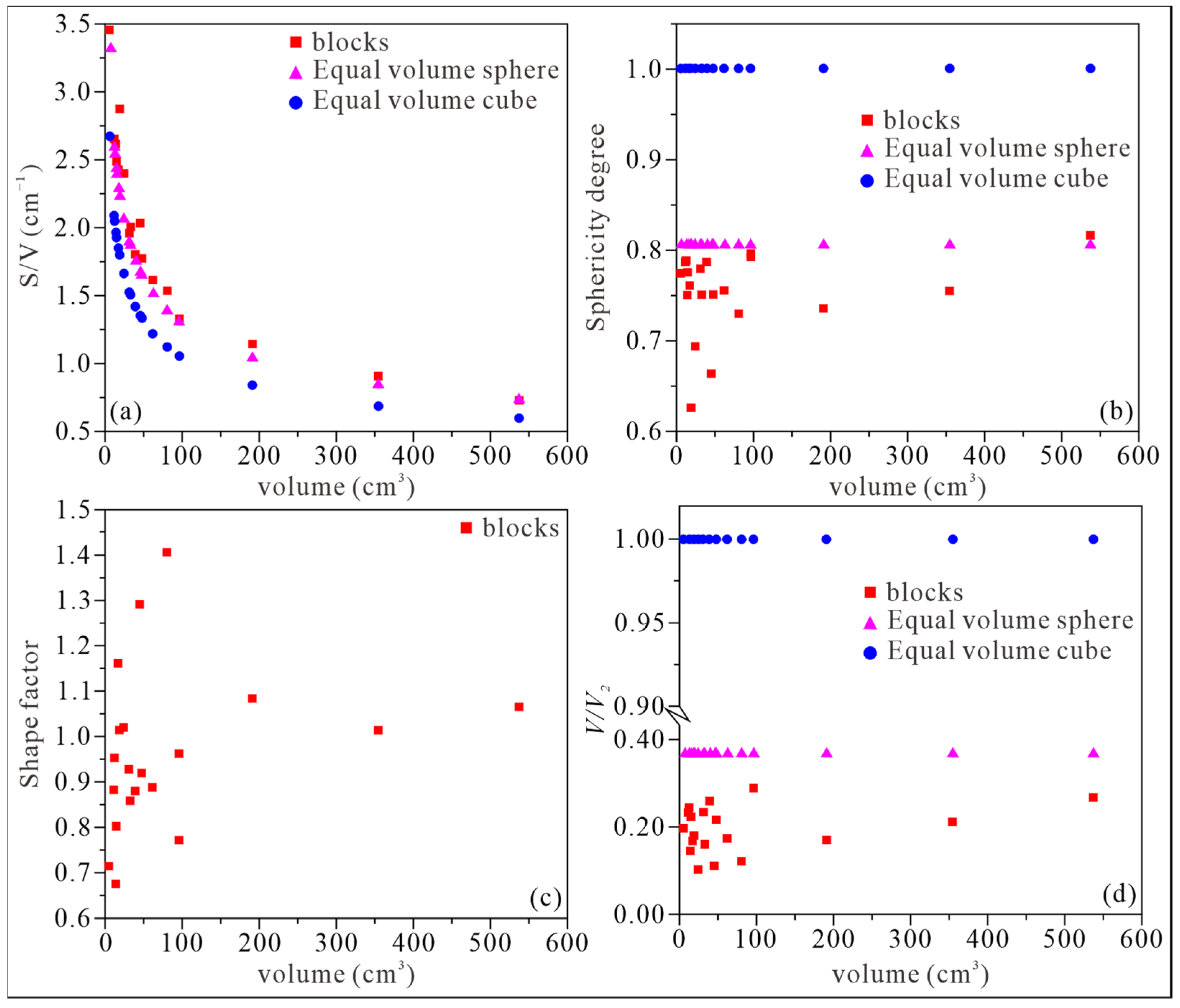


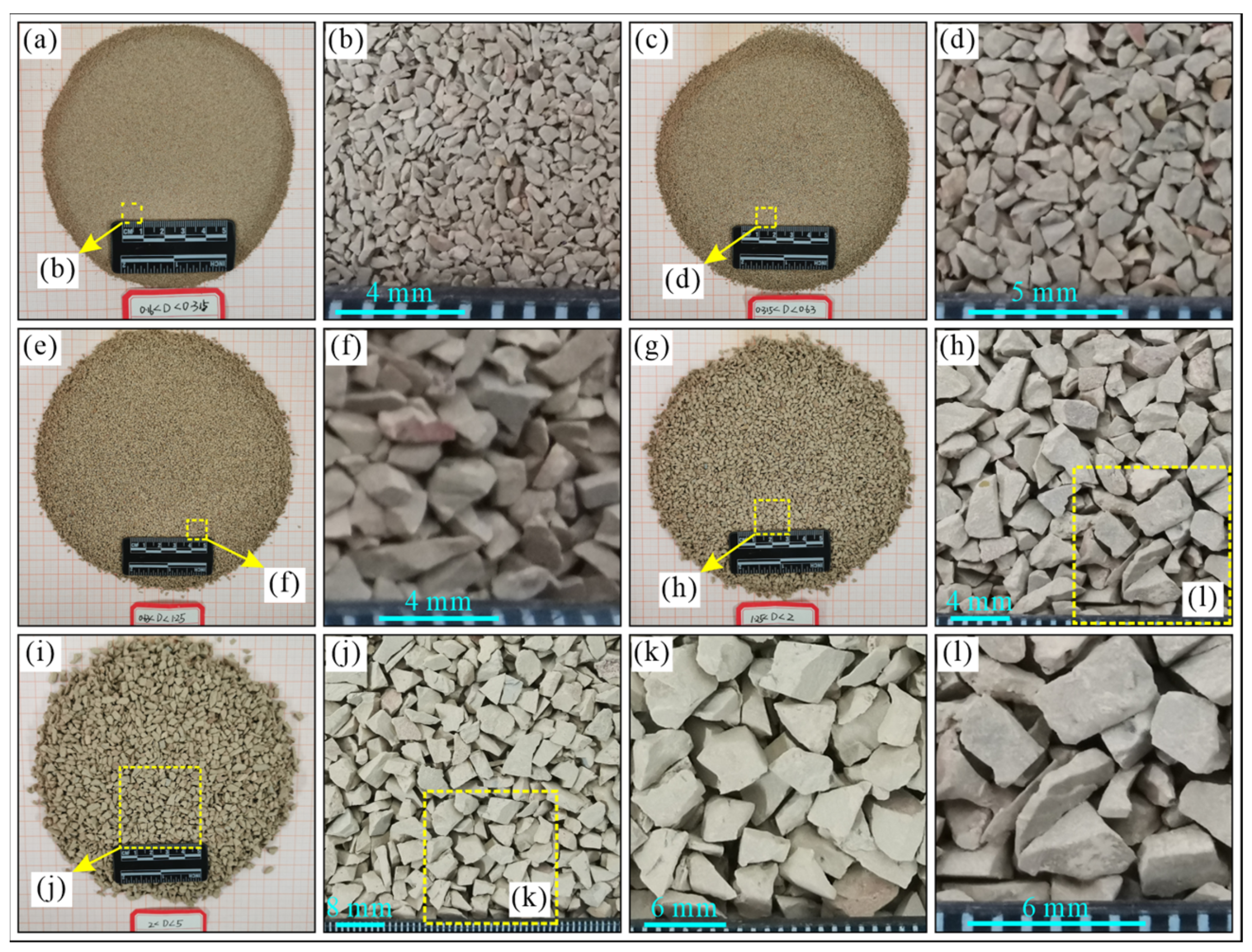
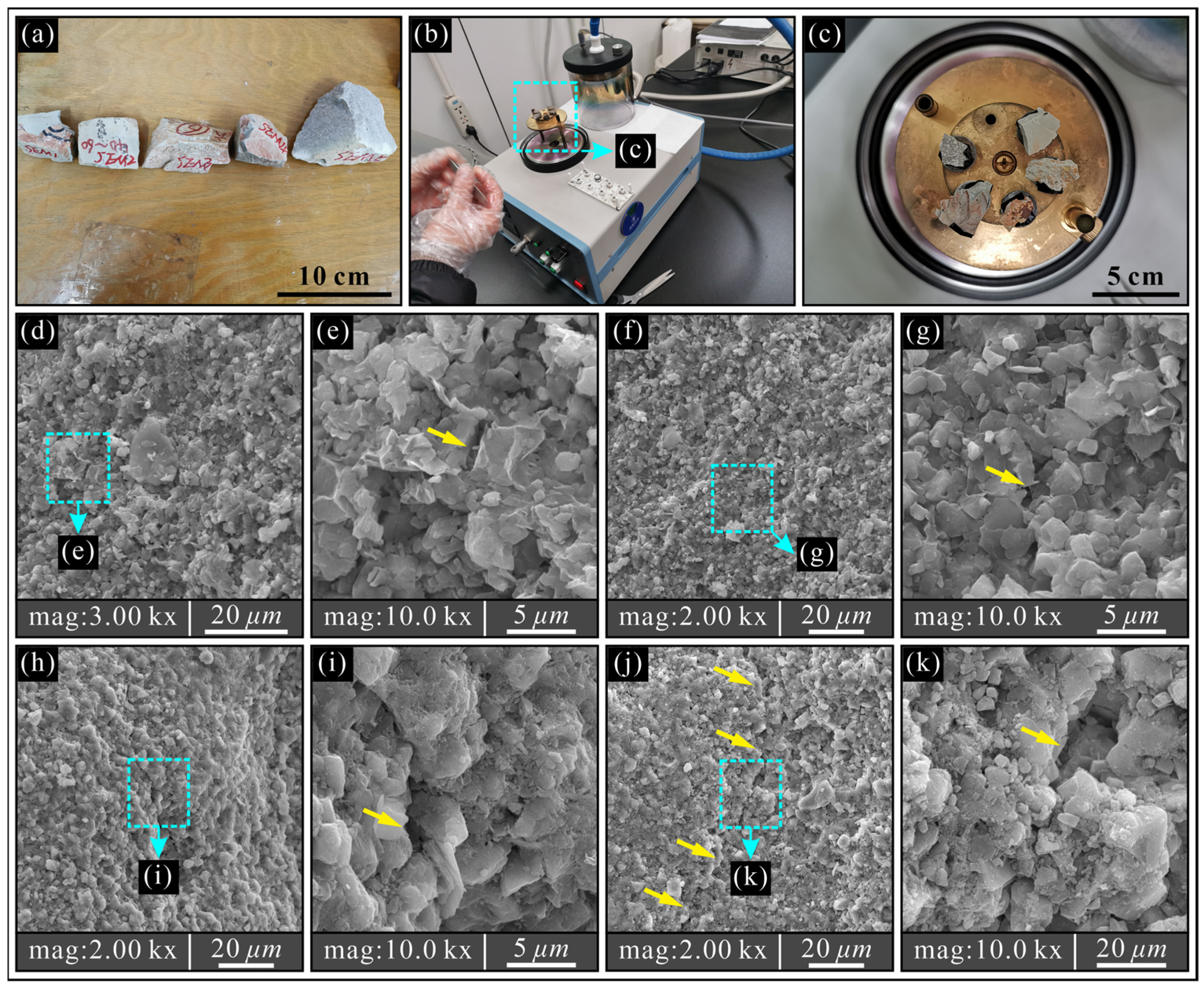
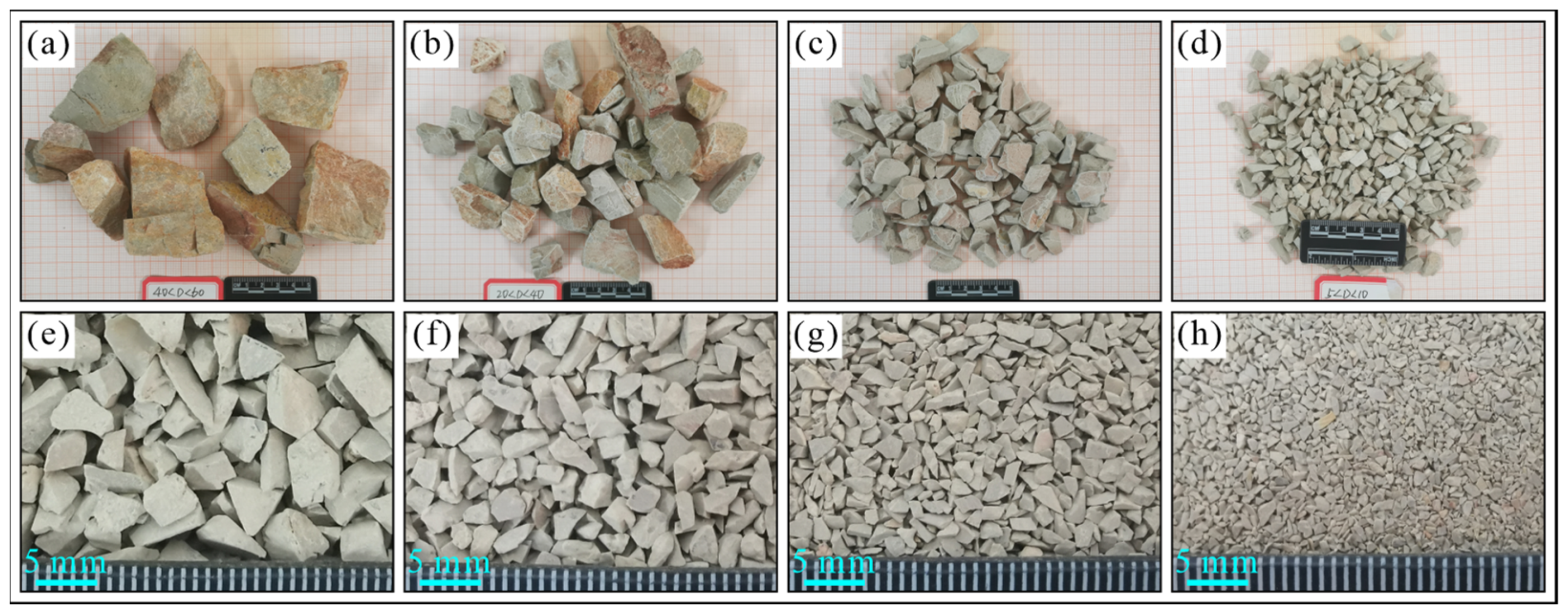

Disclaimer/Publisher’s Note: The statements, opinions and data contained in all publications are solely those of the individual author(s) and contributor(s) and not of MDPI and/or the editor(s). MDPI and/or the editor(s) disclaim responsibility for any injury to people or property resulting from any ideas, methods, instructions or products referred to in the content. |
© 2023 by the authors. Licensee MDPI, Basel, Switzerland. This article is an open access article distributed under the terms and conditions of the Creative Commons Attribution (CC BY) license (https://creativecommons.org/licenses/by/4.0/).
Share and Cite
Tian, L.; Liu, W.; Zhang, J.; Gao, H. Cataclastic Characteristics and Formation Mechanism of Dolomite Rock Mass in Yunnan, China. Appl. Sci. 2023, 13, 6970. https://doi.org/10.3390/app13126970
Tian L, Liu W, Zhang J, Gao H. Cataclastic Characteristics and Formation Mechanism of Dolomite Rock Mass in Yunnan, China. Applied Sciences. 2023; 13(12):6970. https://doi.org/10.3390/app13126970
Chicago/Turabian StyleTian, Lin, Wenlian Liu, Jiaming Zhang, and Haiyan Gao. 2023. "Cataclastic Characteristics and Formation Mechanism of Dolomite Rock Mass in Yunnan, China" Applied Sciences 13, no. 12: 6970. https://doi.org/10.3390/app13126970
APA StyleTian, L., Liu, W., Zhang, J., & Gao, H. (2023). Cataclastic Characteristics and Formation Mechanism of Dolomite Rock Mass in Yunnan, China. Applied Sciences, 13(12), 6970. https://doi.org/10.3390/app13126970





